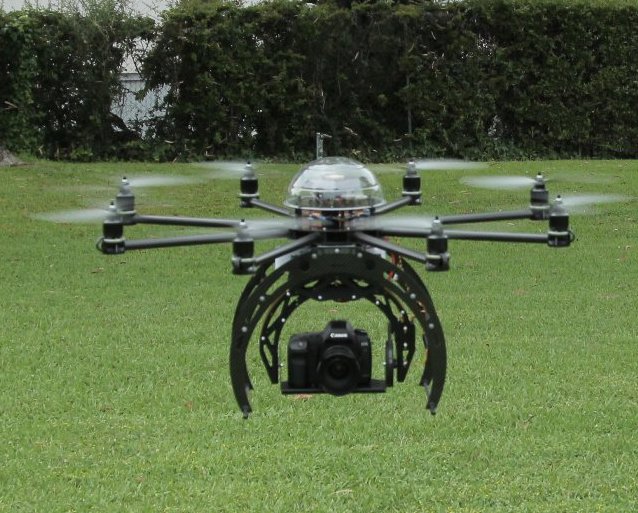Flying into the future with commercial drones
The whir of drone rotor blades may soon become commonplace in cities as more companies turn their focus to commercializing drone activities
Commercial drones, or unmanned aerial vehicles (UAV), have already been used for photography, military operations, and surveying crops on farms. Companies such as Amazon hope to commercialize drones even further through drone-delivered packages.
“Drones put air-based cameras in the hands of the populace,” photography teacher Josh Martinez said. “Images that were, up to this point, only made by large companies or government entities, usually with surveillance intentions, are now able to be made by a much larger swath of people with different motivations for image-making.”
Camera vendor GoPro, best known for its mobile, wearable cameras, has already created commercially available camera-mounted drones for taking aerial pictures. Package and parcel delivery company Deutsche Post DHL has already tested an experimental drone, known as a “parcelcopter,” to drop off medical supplies in inaccessible areas. The company, however, has no plans to use the drones on a regular basis.
Although the Federal Aviation Association (FAA) currently bans all commercial use of drones, it is reconsidering its policy in light of companies such as Amazon hoping to integrate drone technology.
The idea of drones hovering over cities raises privacy and safety concerns with both citizens and the FAA.
“It’s definitely a privacy issue, sort of like we had that issue with [the Google Maps cars] driving around,” Leslie Tzeng (12) said. “Drones make it a lot easier for other companies [to do the same].”
Likewise, Martinez believes that drone commercialization could turn into a privacy concern.
“Any image made from the air has strong connotations to surveillance. With this comes questions about privacy, usage control, and rights to access,” Martinez said.
Preethi Kandappan (9) believes that the current infeasibility of using commercial drones will harm the success of the technology.
“Well, I think in theory that they’re a good idea, but I can see how there would be many problems with it,” she said. “I’m fine with the current way of getting the packages shipped to me. I don’t think it’s necessary to have 30 minute shipping.”
Other students, like Misha Tseitlin (9), believe that the progress with drones has potential, but are worried about government intervention.
“The concept of instant delivery is a great field. The problem is whether the government will allow it,” he said. “Those regulations prevent domestic drone tests mainly outside of the military, giving it a monopoly over drone production while simultaneously limiting its potential.”
Though the technology is readily available, drones are limited by regulations and will not be available for a while. Drones could be very useful in daily life and may soon be as ordinary as door to door deliveries.
This piece was originally published in the pages of the Winged Post on May 16, 2014.


















![“[Building nerf blasters] became this outlet of creativity for me that hasn't been matched by anything else. The process [of] making a build complete to your desire is such a painstakingly difficult process, but I've had to learn from [the skills needed from] soldering to proper painting. There's so many different options for everything, if you think about it, it exists. The best part is [that] if it doesn't exist, you can build it yourself," Ishaan Parate said.](https://harkeraquila.com/wp-content/uploads/2022/08/DSC_8149-900x604.jpg)




![“When I came into high school, I was ready to be a follower. But DECA was a game changer for me. It helped me overcome my fear of public speaking, and it's played such a major role in who I've become today. To be able to successfully lead a chapter of 150 students, an officer team and be one of the upperclassmen I once really admired is something I'm [really] proud of,” Anvitha Tummala ('21) said.](https://harkeraquila.com/wp-content/uploads/2021/07/Screen-Shot-2021-07-25-at-9.50.05-AM-900x594.png)







![“I think getting up in the morning and having a sense of purpose [is exciting]. I think without a certain amount of drive, life is kind of obsolete and mundane, and I think having that every single day is what makes each day unique and kind of makes life exciting,” Neymika Jain (12) said.](https://harkeraquila.com/wp-content/uploads/2017/06/Screen-Shot-2017-06-03-at-4.54.16-PM.png)








![“My slogan is ‘slow feet, don’t eat, and I’m hungry.’ You need to run fast to get where you are–you aren't going to get those championships if you aren't fast,” Angel Cervantes (12) said. “I want to do well in school on my tests and in track and win championships for my team. I live by that, [and] I can do that anywhere: in the classroom or on the field.”](https://harkeraquila.com/wp-content/uploads/2018/06/DSC5146-900x601.jpg)
![“[Volleyball has] taught me how to fall correctly, and another thing it taught is that you don’t have to be the best at something to be good at it. If you just hit the ball in a smart way, then it still scores points and you’re good at it. You could be a background player and still make a much bigger impact on the team than you would think,” Anya Gert (’20) said.](https://harkeraquila.com/wp-content/uploads/2020/06/AnnaGert_JinTuan_HoHPhotoEdited-600x900.jpeg)

![“I'm not nearly there yet, but [my confidence has] definitely been getting better since I was pretty shy and timid coming into Harker my freshman year. I know that there's a lot of people that are really confident in what they do, and I really admire them. Everyone's so driven and that has really pushed me to kind of try to find my own place in high school and be more confident,” Alyssa Huang (’20) said.](https://harkeraquila.com/wp-content/uploads/2020/06/AlyssaHuang_EmilyChen_HoHPhoto-900x749.jpeg)



